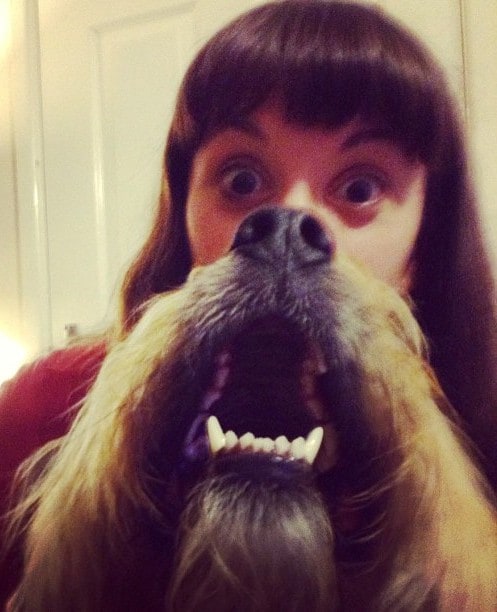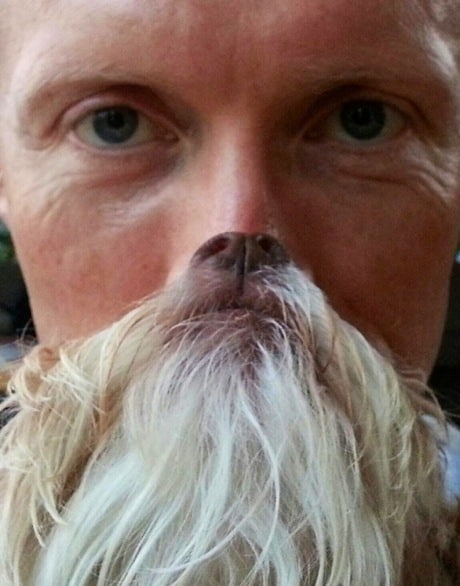Top 5 Tips for Safe Cat and Dog Bearding
In the past few months, I’ve posted some grim articles having significant relevance to animal welfare (see links at the end of this piece, as I don’t want to bring anyone down). I’ve decided to lighten up this week’s feature so that we can all have a little fun. Here goes…
Are you aware of the hottest trend in “selfies” (photos we take of ourselves with our own cameras)?
Start the drum roll! Get ready for it!
The latest trend is cat bearding, which recently appeared on the Huffington Post UK Comedy section. This trend involves the use of a cat’s nose, chin, and mandible (jaw) to lend the appearance of a man or woman having facial hair.
I figured, why should this trend just be left to our feline friends and their aficionados when we canine connoisseurs can get involved as well? Well, it turns out that I wasn’t the only one thinking that dogs should also have their day and try to one-up the cats.
After shooting some of my own versions of dog bearding (photo below), I discovered another Huffington Post article, Dog Beards: Pet Owners Fight The Cat Beard Trend, which features dog lovers putting their own spin on the cat bearding tread. My favorite has to be a Twitter post from Vikki Stone (@vikkistone), who tweeted:
Have you seen my dog beard? Found the cat beard too hard to master... http://t.co/OB7EfZU4fj
Although the trend of cat and dog bearding looks quite fun for people, it’s important that we owners never force our feline and canine companions to participate in such activities against their will. The attempts to direct the nose skyward is actually a movement called crania dorsiflexion (with cranial pertaining to the head and dorsiflexion meaning to direct a body part upward).
If an unwilling pet puts up a fight during this process, it could potentially lead to traumatic injury to the muscles, ligaments, tendons, disks, vertebrae (backbones), facets (small joints holding the vertebrae in place), or even the spine and its emanating nerves. With abrupt or aggressive dorsiflexion of the skull, the dorsal surface (“backside”) of the cervical (neck) vertebral and spinal columns will be compressed, especially at the base of the skull there the atlas and axis (the first and second cervical vertebrae, respectively) are located.
So, if you are going to engage your pet in a cat or dog bearding session, make sure you prioritize safety in the process. Here are my top 5 tips for safe cat and dog bearding:
1. Only have a pet that is exhibiting calm energy participate in cat or dog bearding. If your pet seems overly excited, first take a few minutes to provide gentle hand strokes down the spine to achieve a calmer state.
2. Sit down behind your pet and situate him in a location where he can also comfortably sit before you dorsiflex his head. Sitting, instead of lying down or standing up, will allow for a less severe angle, which will reduce the likelihood of injury to the cervical vertebrae upon cranial dorsiflexion.
3. Dorsiflexion should always be done in a gentle manner; by placing both hands on the margin of the jaw (mandible) just below the ear when directing the chin skyward.
4. Plan your photographic approach ahead of time so that the shoot can be completed within a few takes and your pet does not have to experience the neck being taken into an unnatural position for an unnecessarily long time.
5. Reward your pets with praise throughout the photo shoot and with a healthy food treat once you’ve achieve your best shot.
I hope that you and your cat or dog have a safe and fun time should you choose to do your own version of cat and/or dog bearding, and that you get some hilarious photos. Here are my two entries:
Phil and Cardiff Dog-Beard
Patrick and Lucia Dog-Beard
Feel free to tweet your cat or dog bearding photos to @HuffPostUK. Perhaps you and your pet will be featured.
Here are those links to the grim articles I spoke of as above:
Woman Who Hoarded Cats Meets Tragic End
Gang Tattoo Discovered on Abandoned Dog in California
Dog’s Horrific 4th of July Trauma Reinforces Need for Firework Safety
Toxic Meatballs Poisoning San Francisco Dogs

Dr. Patrick Mahaney
Images: Patrick and Lucia Dog-Bearding; Phil and Cardiff Dog-Bearding



